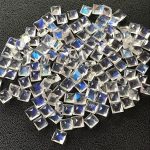This stone’s deposits are found in Canada, Australia, India, Madagascar, Mexico, Myanmar (Burma), Russia, Sri Lanka (Ceylon) and the USA. These stones have been in use for a very long time, and have been found in pieces dating back over 2000 years, both in Oriental countries and in Moonstone Jewelry from the Roman empire. you see those cycles meditated strongly inside the existence of each woman, and the pull of the tides strongly influences each being in the World.
Rainbow Moonstone has been used in Roman Jewelry for nearly two thousand years, even longer in the Orient.
Rainbow Moonstone comes in a variety of Labradorite that exhibits a Blue or multicolored presence on light body color. It has always been a Sacred Stone in India with a special significance for enthusiasts and is a conventional wedding gift there.
 Rainbow Moonstone is usually colorless with a blue or, in rare cases, it may have a Rainbow-Colored Sheen. The blue sheen is highly valued, so Gemstones that exhibit the strongest blue sheen are most sought after. A strong blue Sheen is sometimes referred to as “Royal Blue”.When you move these Stones around often you will see beautiful colors reflected back at you. Rainbow Moonstone is a member of the feldspar organization, which makes up approximately 60% of the Earth’s crust.
Rainbow Moonstone is usually colorless with a blue or, in rare cases, it may have a Rainbow-Colored Sheen. The blue sheen is highly valued, so Gemstones that exhibit the strongest blue sheen are most sought after. A strong blue Sheen is sometimes referred to as “Royal Blue”.When you move these Stones around often you will see beautiful colors reflected back at you. Rainbow Moonstone is a member of the feldspar organization, which makes up approximately 60% of the Earth’s crust.





